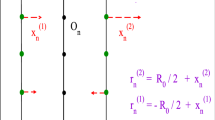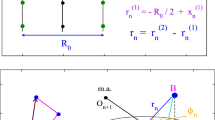Abstract
Simplified elastic rod models of DNA were developed in which the rigidity of DNA is sequence dependent and asymmetrical, i.e. the bending is facilitated towards the major groove. By subjecting the models to bending load in various directions perpendicular to the longitudinal axis of DNA, the bending deformation and the average conformation of the models can be estimated using finite element methods. Intrinsically curved sequence motifs [(aaaattttgc)n, (tctctaaaaaatatataaaaa)n] are found to be curved by this modelling procedure whereas the average conformation of homopolymers and straight motifs [(a)n, (atctaatctaacacaacaca)n] show negligible or no curvature. This suggests that sequence dependent asymmetric rigidity of DNA can provide an explanation in itself for intrinsic DNA curvature. The average rigidity of various DNA sequences was calculated and a good correlation was found with such quantities as the free energy change upon the binding of the Cro repressor, the base stacking energy and the thermal fluctuations at room temperature.
Similar content being viewed by others
References
Travers, A.A. and Klug, A.: In N.R. Cozzarelli and J.C. Wang (eds), DNA topology and its biological effects, Cold Spring Harbour Laboratory Press, Cold Spring Harbour, N.Y., 1990, pp. 57–106.
Travers, A.A.: DNA transcription, keeping the writhe, Curr. Biol. 4 (1994), 659–661.
Ulyanov, N.B. and Zhurkin, V.B.: Sequence dependent anisotropic flexibility of B-DNA: A conformational study, J. Biomol. Str. Dyn. 2 (1984), 361–385.
Calladine, C.R. and Drew, H.R.: Principles of sequence dependent flexure of DNA, J. Mol. Biol. 192 (1986), 907–918.
Wu, H-M. and Crothers, D.M.: The locus of sequence directed and protein induced DNA bending, Nature 308 (1984), 509–513.
Haran, T.E., Kahn, J.D. and Crothers, D.M.: Sequence elements responsible for DNA curvature, J. Mol. Biol. 244 (1994), 135–143.
Lavery, R. and Hartmann, B.: Modelling DNA conformational mechanics, Biophys. Chem. 50 (1994), 33–45.
Vologodskii, A.V. and Frank-Kamenetskii, M.D.: Modelling supercoiled DNA, Methods Enzymol 211 (1992), 467–480.
Yang, Y., Westcott, T.P., Pederson, S.C., Tobias, I. and Olson, W.K.: Effect of localized bending on DNA supercoiling, Trends. Biochem. Sci. 20 (1995), 313–319.
Olson, W.K.: Simulating DNA at low resolution, Curr. Opin. Str. Biol. 6 (1996), 242–256.
Schlick, T. and Olson, W.K.: Supercoiled DNA energetics and dynamics by computer simulation, J. Mol. Biol. 223 (1992), 1089–1119.
Barkley, M.D. and Zimm, B.H.: Theory of twisting and bending of chain macromolecules: Analysis of the fluorescence depolarization of DNA, J. Chem. Phys. 70 (1979), 2991–3007.
Yakushevich, L.V.: Nonlinear DNA dynamics, Physica D 79 (1994), 77–86.
Zhurkin, V.B., Ulyanov, N.B., Gorin, A.A. and Jernigan, R.L.: Static and statistical bending of DNA evaluated by Monte Carlo simulations, Proc. Natl. Acad. Sci. USA 88 (1991), 7046–7050.
Sanghani, S., Zakrzewska, K., Harvey, S.C. and Lavery, R.: Molecular modelling of (A4T4NN)n and (T4A4NN)n: Sequence elements responsible for curvature, Nucl. Acids Res. 24 (1996), 1632–1637.
Yang, Y., Tobias, I. and Olson, W.K.: Finite element analysis of DNA supercoiling, J. Chem. Phys. 98 (1993), 1673–1686.
Bauer, W.R., Lund, R.L. and White, J.H.: Twist and writhe of a DNA loop containing intrinsic bends, Proc. Natl. Acad. Sci. 90 (1993), 833–837.
Calladine, C.R. and Drew, H.R.: Understanding DNA: the molecule and how it works, Academic Press, 1992.
Smith, S.B., Cui, Y. and Bustamante, C.: Overstretching B-DNA: The elastic response of individual double stranded and single stranded DNA molecules, Science 271 (1996), 795–799
Strick, T.r., Allemand, J-F., Bensimon, D., Bensimon, A. and Croquette, V.: The elasticity of a single supercoiled molecule, Science 271 (1996), 1835–1837.
Smith, S.B., Finzi, L. and Bustamante, C.: Direct mechanical measurements of the elasticity of single DNA molecules by using magnetic beads, Science 258 (1992), 1122–1126.
Hogen, M.E. and Austin, R.H.: Importance of DNA stiffness in protein-DNA bending specificity, Nature 329 (1987), 263–266.
Brukner, I., Sanchez, R., Suck, D. and Pongor, S.: Sequence dependent bending propensity of DNA as revealed by DNase I parameters for trinucleotides, EMBO J. 14 (1995), 1812–1818.
Brukner, I., Sanchez, R., Suck, D. and Pongor, S.: Trinucleotide models for DNA bending propensity: Comparison of models based on DNase I digestion and nucleosome packaging data, J. Biomol. Str. Dyn, 13 (1995), 309–317.
Ulanovsky, L., Bodner, M., Trifonov, E.N. and Choder, M.: Curved DNA: Design, synthesis and circularization, Proc. Natl. Acad. Sci. USA 83 (1986), 862–866.
Bathe, K.J., Finite element procedures in engineering analysis, Prentice-Hall, Englewood Cliffs, N.Y., USA, 1992.
Zienkiewicz, O.C. and Taylor, R.L.: The finite element methods, 4th edn, McGraw-Hill, 1991.
COSMOS/M, Release 1.75, User manual, SARC, Santa Monica, Calif., USA 1995.
Rhodes, D.: Nucleosome cores reconstituted from poly-(dA.dT) and the octamer of histones, Nucl. Acids Res. 6 (1979), 1805–1816.
Bednar, J., Furrer, P., Katritch, V., Stasiak, A.Z., Dubochet, J. and Stasiak, A.: Determination of DNA persistance length by cryo-electron microscopy: separation of the static and dynamic contributions to the apparent persistance length of DNA, J. Mol. Biol. 254 (1995), 579–594.
Hagerman, P.J.: Sequence directed curvature of DNA, Nature 321 (1986), 449–450.
Takeda, Y., Sarai, A. and Rivera, V.: Analysis of the sequence-specific interactions between Cro repressor and operator DNA by systematic base substitution experiments, Proc. Natl. Acad. Sci. USA 86 (1989), 439–443.
Baleja, J.D., Pon, R.T. and Sykes, B.D.: Solution structure of phage lambda half-operator DNA by use of NMR, restrained molecular dynamics, and NOE octamer of histones, Biochemistry 29 (1990), 4228–4239.
Lyubchenko, Y.L., Shlyakhtenko, L.S., Chernov, B.K. and Harrington, R.E.: DNA bending induced by Cro protein binding as demonstrated by gel electrophoresis, Proc. Natl. Acad. Sci. USA 88 (1991), 5331–5334.
Lyubchenko, Y.L., Shlyakhtenko, L.S., Appella, E. and Harrington, R.E.: CA runs increase DNA flexibility in the complex of Cro protein with OR3 site, Biochemistry 34 (1993), 4121–4127.
Erie, D.A., Yang, G., Schultz, H.C. and Bustamante, C.: DNA bending by Cro protein in specific and nonspecific complexes: Implications for protein site recognition and specificity, Science 266 (1994), 1562–1566.
Ponnuswamy, P.K. and Gromiha, M.M.: On the conformational stability of oligonucleotide duplexes and tRNA molecules, J. Theor. Biol. 169 (1994), 419–432.
Author information
Authors and Affiliations
Corresponding author
Rights and permissions
About this article
Cite this article
Gromiha, M.M., Munteanu, M.G., Gabrielian, A. et al. Anisotropic elastic bending models of DNA. J Biol Phys 22, 227–243 (1996). https://doi.org/10.1007/BF00401875
Accepted:
Issue Date:
DOI: https://doi.org/10.1007/BF00401875




